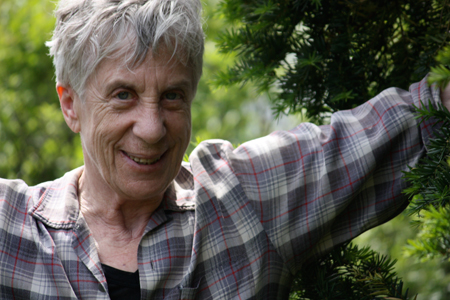
Jill Godmilow
WoIn our times of instant tweets, Facebook feeds and Instagram likes, the idea that a piece of art can stay dormant for dozens of years seems almost surreal. But new technology can also dust off a long forgotten jewel. As it did for Jill Godmilow’s 1984 feature documentary, Far From Poland. After 30 years, it just premiered in Poland, in April 2015, at the Museum of Modern Art in Warsaw. Godmilow has been awarded the Order of Merit of The Republic of Poland by President Bronisław Komorowski.
New technology also bridged Warsaw and New York, enabling me to speak with Jill Godmilow – an Oscar-nominated filmmaker affectionately known as Jilski – on May 27th about her old film, and her new popularity in Poland.
A.N. Do you recall your first, personal frame after you landed in Poland in the 70s?
J.G. My first taxi drive from Okęcie Airport into Warsaw in 1976. The taxi driver figured out that I was from New York, he spoke a little English, so we talked, and he said: “It’s such a beautiful city, New York. There is no crime there at all.” And I asked: “Why do you say that? There is plenty of crime in New York.” Especially that we were talking in the 70s. And he said: “Oh, I know it, because all of our newspapers always write about how much crime there is in New York, so we always know when they are lying.”
A.N. Nobody believed the official propaganda of the communist press back then.
J.G. Yes, he and others were always reading everything in reverse but this time they got too far. And then I remember asking him, as we drove by the fields: “What is it in all those fields?” It was in the middle of the winter. And he said: “Beets.” It seemed like all of Poland must have been living on beets. There was just field after field, mile after mile, beets…
A.N. Did you get to enjoy those beets at the restaurants?
J.G. The food was horrible. We would go to some pretty good restaurants and there would be 10 pages of menus, and you’d say: “Okay, I’ll have this,” and they’d say: “We don’t have this,” and you’d go through eight things that you wanted, and that they didn’t have, and then finally you’d always get steak-fried chicken or chicken-fried steak. But the bread was good.
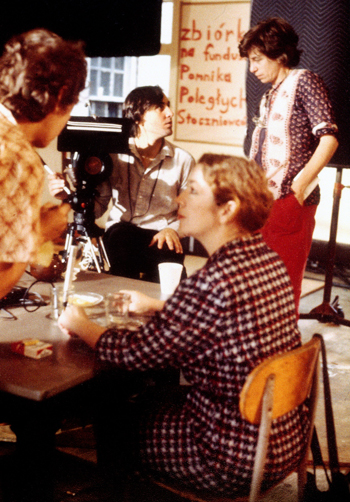
Scene in Godmilow apartment, “Jilski” standing.
A.N. What brought you to Poland in 1976?
J.G. I went there with a wonderful woman, Chiquita Gregory, a theatre producer and a documentary filmmaker, as well as the wife of Andre Gregory, a theatre director who had spent some time with Jerzy Grotowski. Grotowski asked that Chiquita come to Poland to make a film about a young artistic group Gardzienice, just founded by Włodzimierz Staniewski. Gardzienice went from village to village, performing, with a lot of juggling and singing. So we went to Poland, and we made a film that ended up never being distributed. I will probably never find out the real story, but we were later told that there was one scene, happening at night, with Polish peasants singing, and the woman who appeared most on the camera in this scene had a gold, shinning front tooth. That’s why it wouldn’t pass the censor. The censor thought the scene made it looked like there was no good dentistry in Poland. Then Grotowski asked Chiquita and myself to make another film, in Milan, at a conference featuring Grotowski called At the Frontier of Theatre, and so we did. Soon after, in 1980, he wanted us to bring a crew and travel with him to a little village called Nienadówka, just west of Rzeszów. It was there, in Nienadówka, where he himself and his brother and his mother had been sheltered by a Polish peasant family during the Nazi occupation of Poland during WWII. Grotowski considers this time and place as the spiritual beginning of his work in the theatre. He had never been back there, and he had some things to say there that he had never said before. When we finished shooting With Jerzy Grotowski, Nienadówka, 1980, the strike broke out at the Gdańsk Shipyard. So here I am, in August 1980, with my first insight telling me it could be the beginning of the end of the Cold War. Immediately, with my crew on a location, I wanted to get to Gdańsk to start a documentary on Solidarity. So I asked Grotowski if that was okay with him, and he answered: “No.”
A.N. Why didn’t he agree?
J.G. I am sure he was right. It was not clear at all how things were going to unfold and what the Russians were going to do. Since we were there by Grotowski’s invitation, he asked me to go back to the States, raise the money for the Solidarity film and come back on my own visa. So I did go back to New York, and I did raise the money pretty quickly, and then I couldn’t get a visa, as Poland became totally overwhelmed by the world’s press.
A.N. What was the turning point in your artistic vision? When did you come up with an idea to combine real-life footage with a scripted and staged film?
J.G. One of my three collaborators was Polish-speaking Andrzej Tymowski. I had asked him to go to Poland with me as my translator, when I still hoped I would receive my visa. He was already receiving documents that were coming out of Solidarity. He translated for me the Anna Walentynowicz interview, which I thought was extraordinary. It basically takes her from being an orphan at the end of the war in the Wołyń region, which used to be part of the Soviet Union* and now is in Ukraine. She talks about wanting to kill herself, as she had nothing to eat. Finally, she met a man, the most important person in her life, who said to her: “Anna, go to the Shipyard! There you have a chance to learn, and to make something of yourself!” And that’s what she did. That interview was the perfect background for Solidarity, to understand how it all could be happening. Soon after, a friend of mine took me to the Public Theatre where I saw a Mabou Mines piece about nuclear energy with a fantastic actress performing – reading – the diaries of Marie Skłodowska Curie. I thought to myself: “With this actress playing Anna Walentynowicz, I can make the film based on the text.” That was a very clear moment for me when I realized there was another way. Which really challenged the idea that one cannot speak about Poland if one does not have an interview with Lech Wałęsa in front of the Shipyard’s gate. So I went ahead, and Andrzej kept feeding me texts.
A.N. You had a bunch of Polish collaborators: actress Elżbieta Czyżewska, sociologist Elżbieta Matynia, a cinematographer Jacek Laskus, a very young assistant, Dariusz Wolski. Was there a patriotic mission among your Polish crew on the set or was it just a project for them?
J.G. I never asked them if that was important to them. But I guess it was. I didn’t pick Jacek Laskus because he was Polish, somebody just recommended him. And for Darek Wolski it was his first job in the States. He was a kid, and now he is a terribly famous cinematographer in Hollywood.
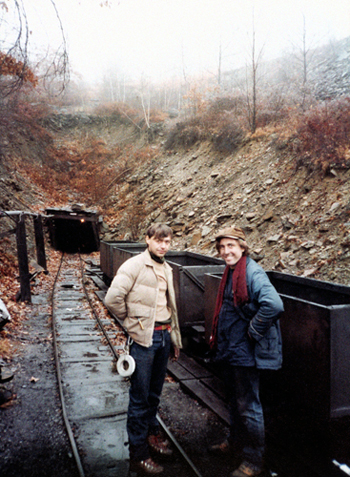
Pennsylvania coal mine
A.N. You shot in New York. Can you elaborate on the filmmaking process?
J.G. The Anna Walentynowicz scene we shot in a high school in New York. The soap opera scenes we shot in my loft, where I am sitting right now. We constructed a faux haute bourgeois editing room for these scenes. Then the other big sequence, the miner’s sequence, we shot in Pennsylvania in a coalmine. There were very few old-fashioned coalmines in this country that were still operating. And then, after martial law was imposed, I didn’t want to finish the film with tragedy, and tears, and mourning, so I found my own way to get up ahead of history. In the film I labeled the Epilog as taking place in 1988. Of course Far From Poland was released in 1984 so I assumed that audiences would understand that this scene couldn’t be historical – that it was my fantasy to get up ahead of history… to propose what Poland would have looked like if Martial Law had failed and the deal between the government and Solidarity had survived. And I made up the story about the great Polish film director, Andrzej Wajda, giving me some leftover footage for my film, to enhance the fantasy.
A.N. You also played in the film under the nickname “Jilski.”
J.G. Yes, Jilski. I just retired from teaching at the University of Notre Dame, and all of my colleagues called me Jilski there, after they saw the film. I still have friends who call me Jilski.
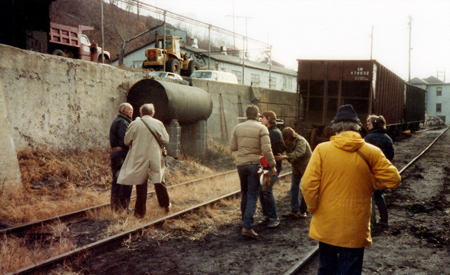
Pennsylvania coal region
A.N. In the 80s, Far from Poland was shown at several film festivals all around the world. Did you hope, back then, to have it screened in Poland as well?
J.G. No. I never expected to go back. One makes a film for one’s home audience. The film premiered in Edinburgh in 1984 where it received a very positive review by the BBC, which was then broadcast into Poland. The Polish communist party decided to respond somehow, so the pro-government Polityka weekly sent its film critic to the next film festival in Manheim, and the reviewer published all those horrible things: that I know nothing about Poland, that I am probably a spy. His biggest claim supporting the theory of my alleged ignorance of Poland was the scene between a reporter, Hanna Krall, interviewing Anna Walentynowicz. At the end, the two actresses pick up a lemon piece and put it into their mouths. That was the biggest argument against the film in Polityka: As all Poles know, lemons come from the West and are covered with poisonous pesticides – no Pole would ever put a wedge of lemon into her mouth. That was the Poland I left. I knew I could never show my film there.
A.N. But you just did: in the year 2015. You just came back from Warsaw, Gdańsk and Łódź. In today’s Poland, is there anything of the Solidarity spirit left?
J.G. The national health care. The free universities. A couple of great subway lines. I was very impressed by your subway. I live in New York and our subway is over 100 years old.
A.N. Warsaw’s subway is brand new but we only have those two lines.
J.G. I know but somehow every place I needed to go was on those two lines. I enjoyed it very much. There were some values that seemed to have been incorporated on a larger public scale that are not at all widespread in my country. Here we have tens of thousands of students in perpetual debt who can’t declare bankruptcy and avoid their student loans. We have horrible public education. We have a health system which isn’t good enough. Your education and health system are going to make Poland a very successful country. Clearly, of all the Eastern European countries that were in the Eastern Block, as far as I can see, Poland is way ahead. I also visited the new Museum of The History of Polish Jews. It’s amazing. It is a very confident country, I would say, that could have built that museum.
A.N. Why?
J.G. They didn’t have to look back at their own history. You know, half of the United States still thinks that Poles happily built concentration camps for the Nazis for the extermination the Jews and others. So to tell that story in a museum and to acknowledge that there has been tremendous anti-Semitism in Poland, and also periods of Polish history when anti-Semitism was forbidden, and to track all that, and to spend a lot of money doing it, and to do it well… well, that’s a courageous action for the modern Polish government to take. If there was a museum in this country about the Vietnam War, I would think that we are paying attention to our own history and learning from it. A lot of learning could come to the States from that Polish museum. It is as well done as it could be. And stuff I’ve never heard of. That there were 10th century Polish kings who said “no” to anti-Semitism. Nobody knows that, and it’s really important.
A.N. For me that is the most significant layer that emerges from this wonderful museum. An unknown testimony of Polish medieval hospitality toward Jews expelled from other European countries, and the Golden Age between Poles and Jews in the Polish Kingdom from XVIth to XVIIIth century. We share such a long, and such a rich mutual history.
J.G. I never knew any of that. I could easily spend a week there. I am Jewish. I lost my family in the Holocaust. Interesting, when I was half way through Far from Poland, I was on radio here in New York. In December 1981 there was this horrible El Mozote Massacre in El Salvador, with the United States supporting the right-wing government whose army killed 800 civilians, against left-wing guerillas. So I am on the open line for listeners to call the radio. Many people called and asked: “Are you a Jew?” And I said: “Yes”. And they’d say: “How can you be making a film about Poland and not about El Salvador? It’s much more important!” These people were questioning the legitimacy of me, a Jew, making a film about Poland. Because Poland was, still is, understood as an anti-Semitic country. So from the Polish perspective, to face this approach, to admit that there were periods of anti-Semitism, and to build a museum… It’s a very confident country.
A.N. How does the Polish audience respond to your film today?
J.G. The reception was unbelievably favorable. There was so much excitement about the film. I gave several interviews. I appeared on a morning show Dzień Dobry TVN. The people at the Museum of Modern Art wanted to buy the rights for the Polish market, as they thought this 31-year-old film is terribly important.
A.N. Why is it important now?
J.G. I think it reminds everybody of what that revolution was about… what its values and goals were. That seems to have been lost in the last decade, especially for the younger generation. I think it was the greatest revolution in the world. Non-violent, supported by 80 per cent of the Polish population, leading to 16 months of precarious negotiations with a government which was severely threatened by it. I think my film, and the strangeness of it being made – as these events were happening – in New York City by an American totally in support of Solidarity, that just made it more extraordinary. Somehow I had made a gift to the Polish people. Today it’s impossible to reconcile what finally came from Solidarity. Clearly, with all the modern capitalistic struggles like unemployment, low wages, for young people the film was like: “Wow, we did that?!”
A.N. How did it feel to you to be watching your film premier in Poland after 31 years?
J.G. I really liked the film. You don’t watch your old films very often, only when somebody else is showing them and they invite you. So I sat there and thought: “Yeah, you’re good, Jill!” Apart from the soap opera scenes where I play. These made me wince.
A.N. How did it happen that Far From Poland was rediscovered?
J.G. By an accident. Over a year ago I wrote a strong article about somebody’s else film, called The Act of Killing. I had never published online before, but a friend of mine convinced me to put it on Indie wire, so I did, and it went viral. A woman filmmaker in Poland read it, liked what I had written, and she looked me up, and she discovered that I made a film about the Solidarity movement in 1984 called Far from Poland. She asked her friend in New York City to find a copy in a public library, and she watched it, and was stunned how good and smart the film was. She visited me here in New York, she went back to Poland, walked into – literally – the Museum of Modern Art in Warsaw with copies of all my films, because she wanted to do a retrospective, and Sebastian Cichocki, the curator in charge said: “Let’s do it!” Just like that.
A.N. And thus your film got a Hollywood happy ending and a second life.
J.G. And an important one. Before I flew to Poland, here in NY there was a vast government check-up on whether I was a terrorist or not. It went through three months and seven levels of bureaucracy, and then the President of Poland awarded me with a medal. He wasn’t there personally that evening but his advisor Henryk Wujec pinned the medal on me.
A.N. Where is your medal now?
J.G. Right over there on a table. I had to leave it out because everybody wants to see it. It’s my proof that I actually went to Poland.
CR
* Walentynowicz was born in 1929 in Rovne, in Wołyń, which was at that time in eastern Poland. After their invasion in 1939 in collaboration with Nazi Germany the Soviets annexed it as part of the Ukrainian SSR.



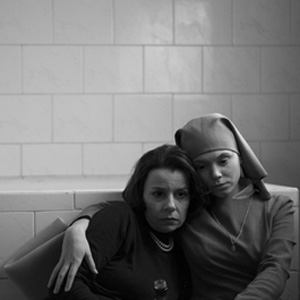
Pingback: Welcome to Summer 2015!
“A woman filmmaker in Poland read it, liked what I had written, and she looked me up, and she discovered” – would make sense to include the name of that woman, pivotal to the whole story…